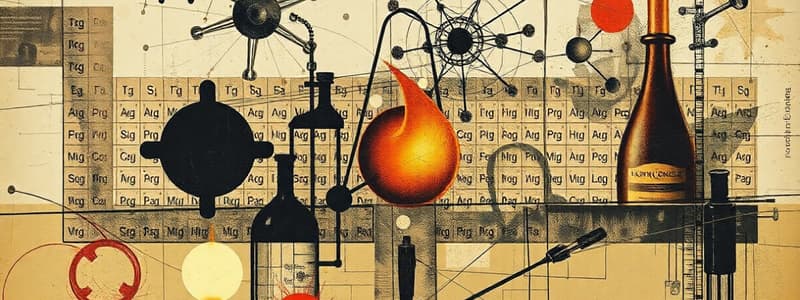Podcast
Questions and Answers
What is the atomic weight calculated by?
What is the atomic weight calculated by?
- Weighted average mass of the element’s isotopes (correct)
- Fixed mass values of each isotope
- Total mass of all isotopes combined
- Sum of the isotopic masses only
What percentage of gallium is Ga-71?
What percentage of gallium is Ga-71?
- 39.6% (correct)
- 60.4%
- 30.0%
- 70.0%
In which part of the periodic table do metals typically occur?
In which part of the periodic table do metals typically occur?
- Right side
- Center
- Bottom
- Left side (correct)
Which of the following is true about nonmetals?
Which of the following is true about nonmetals?
What does the mass number indicate?
What does the mass number indicate?
Who is credited with producing the forerunner of the modern periodic table?
Who is credited with producing the forerunner of the modern periodic table?
How is atomic weight calculated based on isotopes?
How is atomic weight calculated based on isotopes?
What characteristic commonly describes metals?
What characteristic commonly describes metals?
Which statement about atoms is true?
Which statement about atoms is true?
What is the significance of the atomic number?
What is the significance of the atomic number?
Which statement describes the mass of subatomic particles accurately?
Which statement describes the mass of subatomic particles accurately?
What does the term 'atomic mass unit' (amu) refer to?
What does the term 'atomic mass unit' (amu) refer to?
Which of the following best describes the composition of an atom's nucleus?
Which of the following best describes the composition of an atom's nucleus?
Which principle is NOT part of atomic theory?
Which principle is NOT part of atomic theory?
What happens to electrons in relation to the nucleus of an atom?
What happens to electrons in relation to the nucleus of an atom?
Which of these statements about electron configurations is accurate?
Which of these statements about electron configurations is accurate?
What is the mass number of an atom if it contains 15 protons and 16 neutrons?
What is the mass number of an atom if it contains 15 protons and 16 neutrons?
Which of the following statements about isotopes is true?
Which of the following statements about isotopes is true?
How many neutrons are present in a chlorine-35 atom?
How many neutrons are present in a chlorine-35 atom?
If an atom has an atomic number (Z) of 28 and a mass number (A) of 60, how many electrons does it have?
If an atom has an atomic number (Z) of 28 and a mass number (A) of 60, how many electrons does it have?
What is the number of neutrons in a phosphorus atom with a mass number of 31 and atomic number of 15?
What is the number of neutrons in a phosphorus atom with a mass number of 31 and atomic number of 15?
Which element has an atomic number of 17?
Which element has an atomic number of 17?
How is a specific isotope represented in chemical notation?
How is a specific isotope represented in chemical notation?
If sodium has 11 protons, what is the mass number of its most common isotope?
If sodium has 11 protons, what is the mass number of its most common isotope?
Flashcards are hidden until you start studying
Study Notes
Atomic Theory and Structure of Atoms
- Atoms are the smallest identifiable particles of elements, derived from the Greek word "atomos" meaning "indivisible."
- Atomic theory is based on four main assumptions:
- All matter is composed of atoms.
- Atoms of one element differ from those of others.
- Chemical compounds consist of atoms combined in specific ratios.
- Chemical reactions alter the arrangements of atoms, not the atoms themselves.
- Atoms consist of protons (positively charged), neutrons (neutral), and electrons (negatively charged), with protons and neutrons forming the dense nucleus and electrons moving in the surrounding space.
- The mass of an atom is expressed in atomic mass units (amu), with one amu based on the mass of a carbon-12 atom.
Elements and Atomic Number
- Atomic number (Z) indicates the number of protons in an atom; e.g., Sodium (Na) has Z = 11, Magnesium (Mg) has Z = 12.
- Mass number (A) is the total of protons and neutrons in an atom; can be calculated as A = Z + number of neutrons.
- In neutral atoms, the number of protons equals the number of electrons, maintaining overall electrical neutrality.
- Example of phosphorus: Z = 15 and A = 31 gives 15 protons, 15 electrons, and 16 neutrons.
Isotopes and Atomic Weight
- Isotopes are atoms with the same atomic number but different mass numbers due to varying neutron counts.
- Example: Chlorine-35 and Chlorine-37 both have Z = 17 but differ in A (35 and 37, respectively).
- Isotopes of hydrogen include protium, deuterium, and tritium.
- Atomic weight represents the average mass of an element’s isotopes, weighted by their natural abundance.
- Atomic weight calculation: Atomic weight = Σ[(isotopic abundance) × (isotopic mass)].
The Periodic Table
- The periodic table organizes all known elements, displaying their symbols, names, and atomic masses.
- Dmitri Mendeleev created an early version of the periodic table, arranging elements by their properties and atomic weights.
- Elements are classified based on physical and chemical properties:
- Metals are malleable, lustrous, and good conductors, found on the left side of the table.
- Nonmetals are poor conductors and located on the upper-right side of the table.
Studying That Suits You
Use AI to generate personalized quizzes and flashcards to suit your learning preferences.




